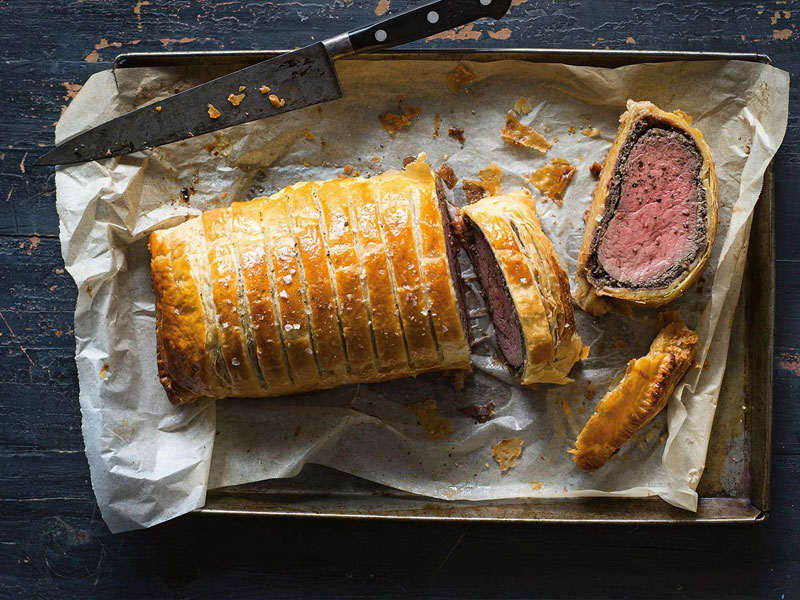Beef Wellington is a culinary wonder – tender filet mignon enveloped in mushroom duxelle, liver pâté, and wrapped in puff pastry, then baked to golden perfection. This classic dish graced fine dining restaurant menus for decades and became a hallmark of exquisite cuisine. But who created this ingenious beef dish? The origin of Beef Wellington is shrouded in mystery and conjecture.
There are several theories about the genesis of the Beef Wellington. According to legend, a cook for Arthur Wellesley, the Duke of Wellington, invented it. The Duke, who defeated Napoleon at the Battle of Waterloo in 1815, supposedly liked food he could eat on the march. The crusted Beef Wellington would certainly travel well. While plausible, there is no evidence that the dish existed during the Duke’s lifetime.
Another account claims the dish was simply named in the Duke’s honor But the contention that the wrapped roast resembled the Duke’s Wellington boots is tenuous at best. The boots, iconic today, were not fashionable in Wellington’s era
Ironically Beef Wellington’s origin likely lies in France, not Britain. Filet de boeuf en croûte tenderloin coated in pastry, resembles a proto-Wellington. French cuisine heavily influenced European upper-class cooking during the early 1800s. Perhaps English chefs adapted filet de boeuf en croûte, renaming it after Wellington following Britain’s victory at Waterloo over France.
The first documented recipe for “beef a la Wellington” emerged in 1903 in an American cookbook by a Palmer House Hotel chef. Julia Child featured filet de boeuf en croûte on her television show The French Chef in the 1960s, introducing Beef Wellington to America. It became a refined dining favorite, appearing in the White House kitchens of Presidents Kennedy and Nixon.
While the creator remains ambiguous some clues about Beef Wellington’s origins emerge
-
The French filet de boeuf en croûte predating Beef Wellington indicates the dish originated in French cuisine, not Britain.
-
The earliest known Beef Wellington recipes hail from the United States, not England.
-
Its designation as “a la Wellington” ties it to the Duke rather than arising spontaneously as “Beef Wellington.”
-
The 1903 date of the first documented Wellington recipe suggests its invention long post-dated the Duke’s lifetime in the early 1800s.
The evidence points to an anonymous French chef likely inventing filet de boeuf en croûte. The dish later migrated to England where it was renamed Beef Wellington in tribute to Britain’s battle hero. By 1903, the Beef Wellington entrée had traveled back across the Atlantic to America where its popularity steadily grew over the 20th century.
While the inventor’s identity is lost to time, the dish’s migration reveals the interconnectivity of European and American cuisine. The Beef Wellington’s intricate combination of flavor and texture captivated taste buds on both sides of the Atlantic. This irresistible beef delicacy became an icon of fine dining through the tireless efforts of unknown chefs honing the preparation techniques over decades.
So honor the mysterious genius who had the audacity to wrap beef in pastry however many centuries ago. And salute the countless chefs who elevated Beef Wellington to supreme savory perfection through their skill and artistry. Though its creator will likely never be known, the result of their vision will endure as long as discerning diners savor this opulent beef dish.

Item added to basket
Your browser appears to have Javascript disabled. You may find this causes parts of the site to function unexpectedly. Please enable JavaScript
What is Beef Wellington?
Anyone interested in classic cuisine and fine dining has heard of Beef Wellington, but some might not be familiar with exactly what it is. It is made from beef tenderloin wrapped in pâté, duxelles, parma ham, and then finally wrapped in puff pastry. This process can be extremely time-consuming, but for chefs who know what they’re doing, this dish will impress anyone. Wellington is also difficult to make as you want to ensure that the tenderloin is fully done but not overdone, while also ensuring the puff pastry stays light and airy, rather than getting soggy.
The Delicious Journey: History of Beef Wellington
FAQ
Who originated the Beef Wellington?
Considerable confusion surrounds the origin of beef Wellington. One version that seems more legend than fact attributes it to a cook for the famed duke of Wellington (Arthur Wellesley), the English general who defeated the armies of Napoleon Bonaparte at the Battle of Waterloo in 1815.
What chef is famous for Beef Wellington?
The Beef Wellington would enjoy a firm place in the English culinary scene, even making waves abroad (it was reportedly one of Richard Nixon’s favourites!) But would gain the most popularity when Gordon Ramsay picked it up as his favourite, signature dish.
Who invented the Wellington?
-
Wikipediahttps://en.wikipedia.orgWellington boot – WikipediaThe term Wellington boot comes from Arthur Wellesley, 1st Duke of Wellington, who instructed his shoemaker to create the boot by modifying the design of the Hes…
Is Beef Wellington English or Scottish?
Beef Wellington is a traditional English way of preparing beef tenderloin. Believed to have originated in the 1800s after the Duke of Wellington had a victory at Waterloo in 1815, it was a popular “fancy” dish in the mid-1900s.
